人教版必修2Unit 3 Computers period 1 Warming up(25张PPT)
文档属性
| 名称 | 人教版必修2Unit 3 Computers period 1 Warming up(25张PPT) | 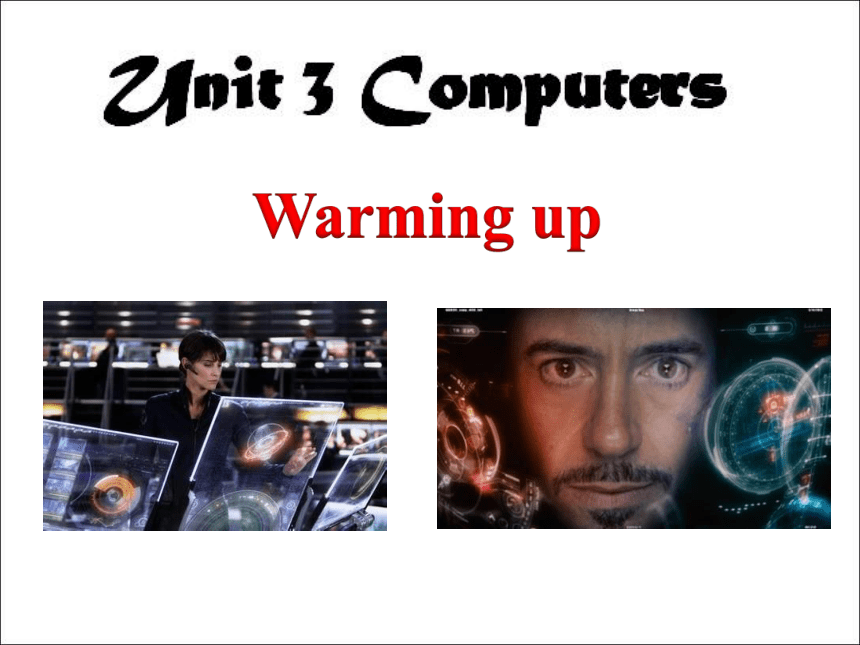 | |
| 格式 | zip | ||
| 文件大小 | 4.9MB | ||
| 资源类型 | 教案 | ||
| 版本资源 | 人教版(新课程标准) | ||
| 科目 | 英语 | ||
| 更新时间 | 2017-10-01 20:05:06 | ||
图片预览

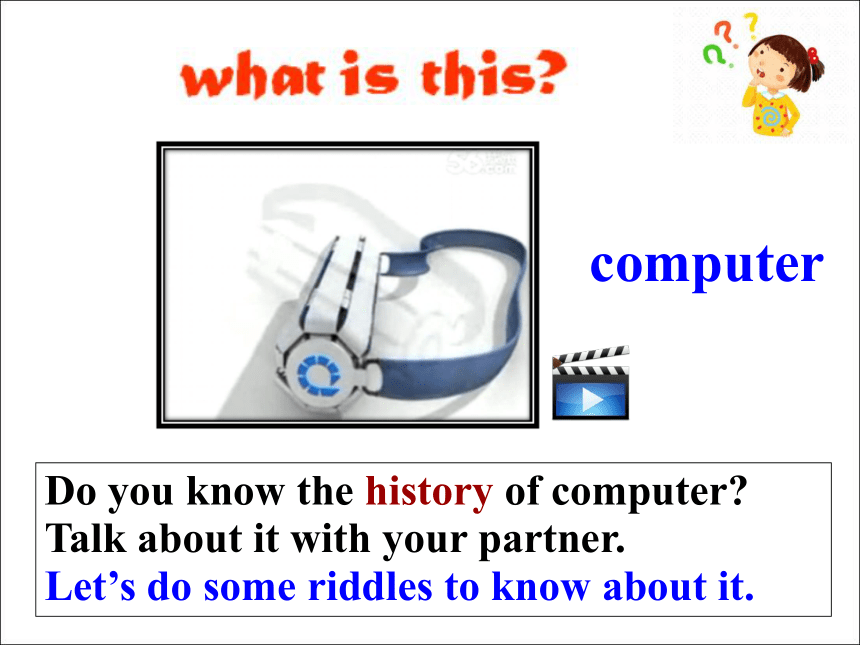

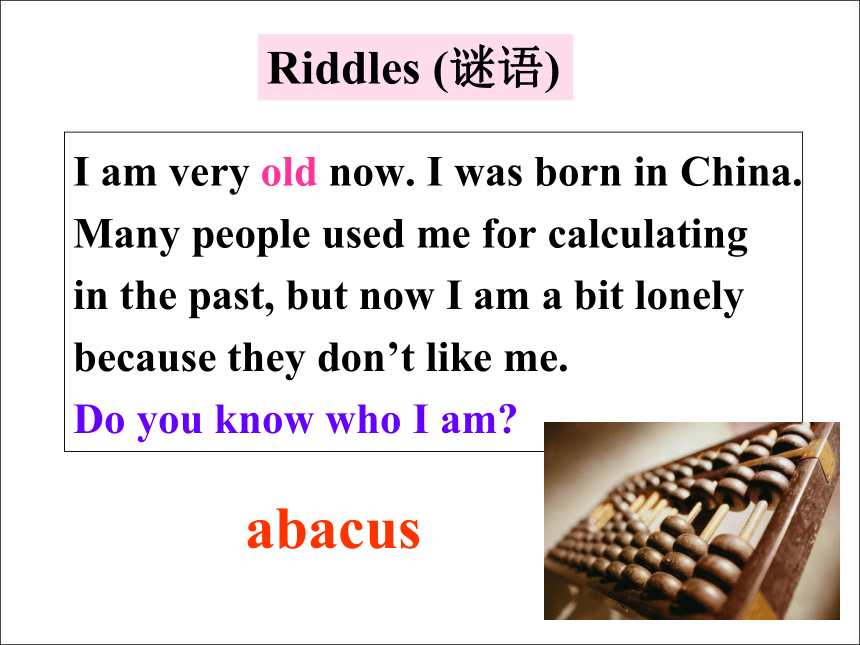

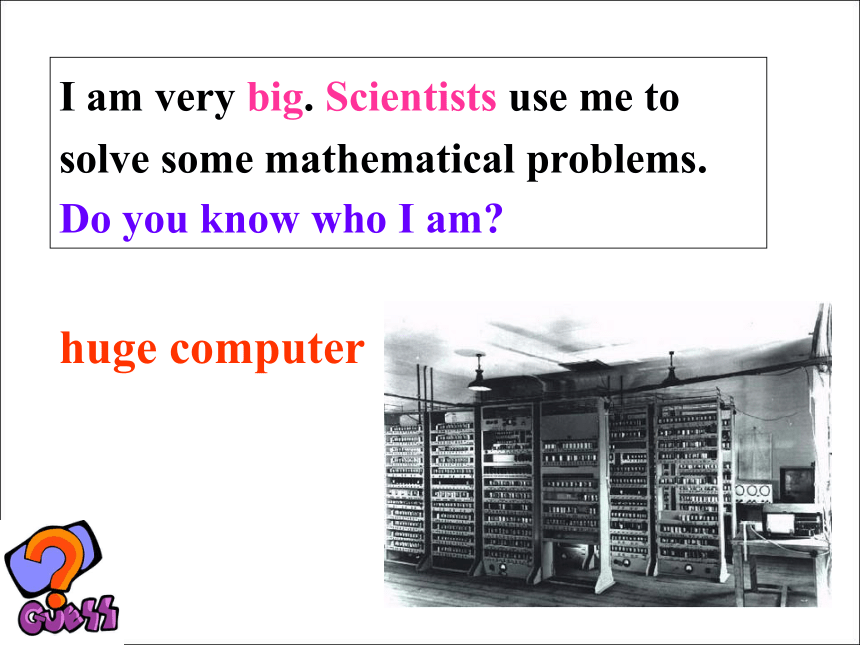
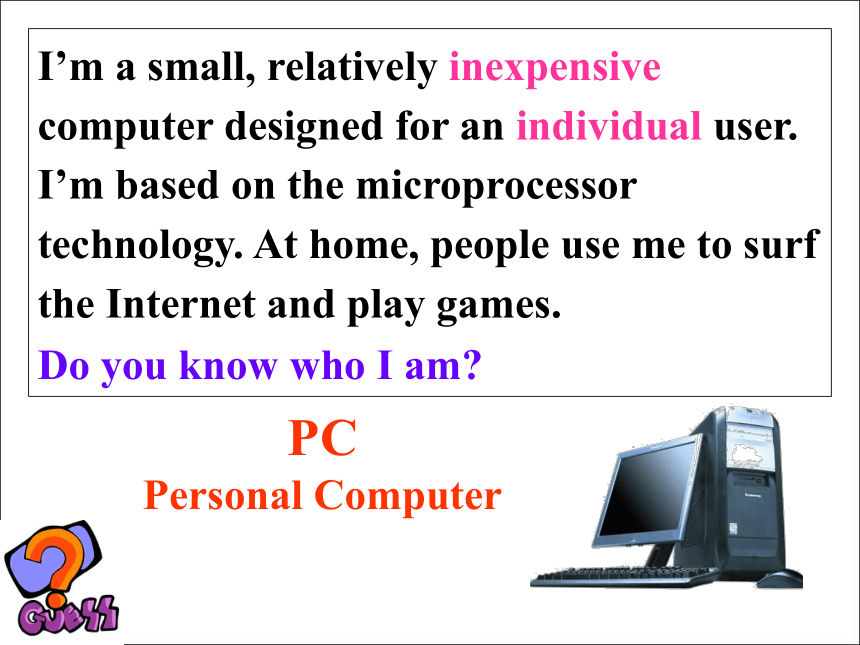
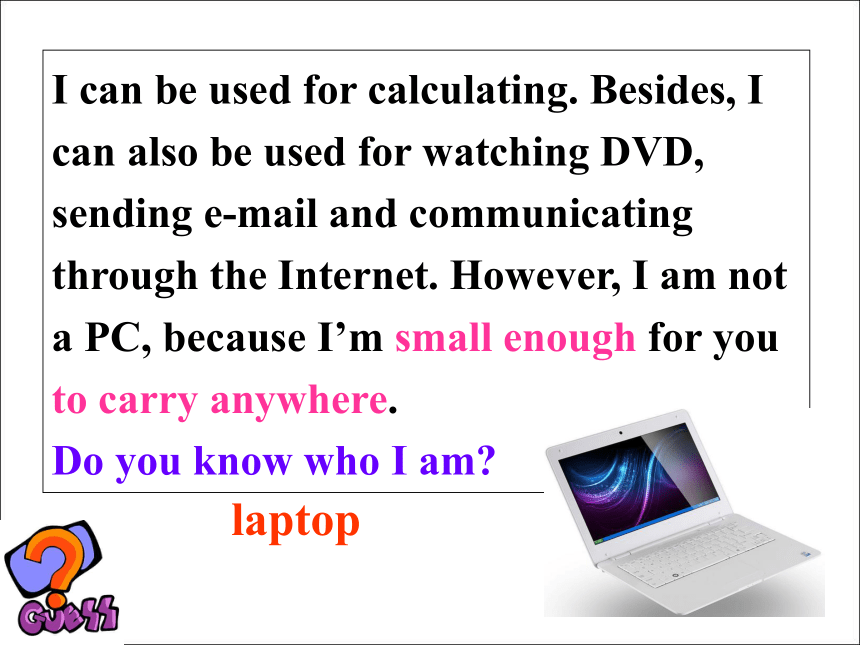
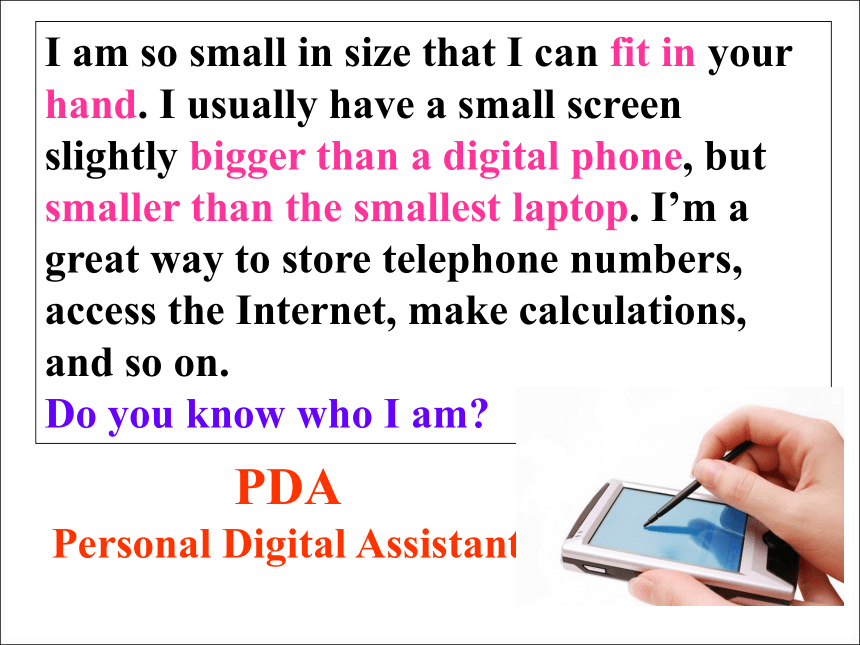
文档简介
课件25张PPT。Warming upcomputerComputer is a programmable electronic device that can store, retrieve, and process data.Do you know the history of computer?
Talk about it with your partner.
Let’s do some riddles to know about it.Let’s guess!I am very old now. I was born in China. Many people used me for calculating in the past, but now I am a bit lonely because they don’t like me.
Do you know who I am?abacusRiddles (谜语)I am very small. I can be used for calculating. In China, a lot of students use me when solving mathematical problems.
Do you know who I am?calculatorI am very big. Scientists use me to solve some mathematical problems.
huge computerDo you know who I am?PC
Personal ComputerI’m a small, relatively inexpensive computer designed for an individual user. I’m based on the microprocessor technology. At home, people use me to surf the Internet and play games.
Do you know who I am?I can be used for calculating. Besides, I can also be used for watching DVD, sending e-mail and communicating through the Internet. However, I am not a PC, because I’m small enough for you to carry anywhere.
Do you know who I am?laptopPDA
Personal Digital AssistantI am so small in size that I can fit in your hand. I usually have a small screen slightly bigger than a digital phone, but smaller than the smallest laptop. I’m a great way to store telephone numbers, access the Internet, make calculations, and so on.
Do you know who I am?robotI’m a machine that works automatically.
I can do a wide variety of tasks, especially suitable for doing jobs too boring, difficult,
or dangerous for human beings.
Do you know who I am?What’s
next?Can you put them in an order according to the time when they appeared?【1】【2】【3】【4】【5】【6】【7】superconducting high-speed computer
高速超导计算机 laser computer
激光计算机molecular computer
分子计算机quantum computer
量子计算机DNA computerneural computer
神经元计算机 biological computer
生物计算机What do you think will be the next development?High performance
computer
in the futureDo you know in what ways computers
are used today?
Work out a list and compare it with
your partner.search for informationsee moviesshop onlineplay games on
the internetchat with friendsdownload music
and filmslisten to musicread books and magazinesComputers have brought great changes to our life. Can you live without computers?Skimming for general idea1. Who is the speaker in this story? 2. What’s the main idea of this passage?
A. The development of computers.
B. The development and use of
computers.
C. A machine which is simple-minded.
D. Computers may replace human beings.A computer.Answer the following questions.Scanning for specific informationThe computer began as a calculating machine.1936The computer grew rapidly both in size and in brainpower.(1) Read the passage and find the development of computers. Finish the table below.P19 11. My real father was Charles Babbage, who wrote a book and built me in 1936.
2. I began as a calculating machine
in Japan in 1642.
3. After 1936, I grew rapidly both in size
and in brainpower.
4. As time went by, I was made bigger.Alan TuringFrancesmaller(3) 1. When was the “universal machine” built?
A. In 1822. B. In 1642.
C. In 1936. D. In 1970.
2. When was the computer the biggest?
A. In 1642. B. In 1936.
C. In the 1940s. D. In the 1970s.(4) Choose the best answer.3. Which of the following is in the right
order of time?
The computer was connected with
other computers.
b. Alan Turing wrote a book about the
computer.
c. The computer has been sent to explore
the Moon and Mars.
d. The computer began to simplify
difficult sums.
A. a. b. c. d. B. b. c. a. d.
C. d. a. c. b. D. d. b. a. c.(5) Answer the questions. 1. What makes computers become smaller?2. What applications have been found for computers since the 1970s?Computer’s memory has been improved. First it was stored in tubes, then on transistors and later on very small chips.The computers have been put into robots and used to make mobile phones as well as help with medical operations. They also have been put into space rockets and sent to explore the Moon and Mars.
Talk about it with your partner.
Let’s do some riddles to know about it.Let’s guess!I am very old now. I was born in China. Many people used me for calculating in the past, but now I am a bit lonely because they don’t like me.
Do you know who I am?abacusRiddles (谜语)I am very small. I can be used for calculating. In China, a lot of students use me when solving mathematical problems.
Do you know who I am?calculatorI am very big. Scientists use me to solve some mathematical problems.
huge computerDo you know who I am?PC
Personal ComputerI’m a small, relatively inexpensive computer designed for an individual user. I’m based on the microprocessor technology. At home, people use me to surf the Internet and play games.
Do you know who I am?I can be used for calculating. Besides, I can also be used for watching DVD, sending e-mail and communicating through the Internet. However, I am not a PC, because I’m small enough for you to carry anywhere.
Do you know who I am?laptopPDA
Personal Digital AssistantI am so small in size that I can fit in your hand. I usually have a small screen slightly bigger than a digital phone, but smaller than the smallest laptop. I’m a great way to store telephone numbers, access the Internet, make calculations, and so on.
Do you know who I am?robotI’m a machine that works automatically.
I can do a wide variety of tasks, especially suitable for doing jobs too boring, difficult,
or dangerous for human beings.
Do you know who I am?What’s
next?Can you put them in an order according to the time when they appeared?【1】【2】【3】【4】【5】【6】【7】superconducting high-speed computer
高速超导计算机 laser computer
激光计算机molecular computer
分子计算机quantum computer
量子计算机DNA computerneural computer
神经元计算机 biological computer
生物计算机What do you think will be the next development?High performance
computer
in the futureDo you know in what ways computers
are used today?
Work out a list and compare it with
your partner.search for informationsee moviesshop onlineplay games on
the internetchat with friendsdownload music
and filmslisten to musicread books and magazinesComputers have brought great changes to our life. Can you live without computers?Skimming for general idea1. Who is the speaker in this story? 2. What’s the main idea of this passage?
A. The development of computers.
B. The development and use of
computers.
C. A machine which is simple-minded.
D. Computers may replace human beings.A computer.Answer the following questions.Scanning for specific informationThe computer began as a calculating machine.1936The computer grew rapidly both in size and in brainpower.(1) Read the passage and find the development of computers. Finish the table below.P19 11. My real father was Charles Babbage, who wrote a book and built me in 1936.
2. I began as a calculating machine
in Japan in 1642.
3. After 1936, I grew rapidly both in size
and in brainpower.
4. As time went by, I was made bigger.Alan TuringFrancesmaller(3) 1. When was the “universal machine” built?
A. In 1822. B. In 1642.
C. In 1936. D. In 1970.
2. When was the computer the biggest?
A. In 1642. B. In 1936.
C. In the 1940s. D. In the 1970s.(4) Choose the best answer.3. Which of the following is in the right
order of time?
The computer was connected with
other computers.
b. Alan Turing wrote a book about the
computer.
c. The computer has been sent to explore
the Moon and Mars.
d. The computer began to simplify
difficult sums.
A. a. b. c. d. B. b. c. a. d.
C. d. a. c. b. D. d. b. a. c.(5) Answer the questions. 1. What makes computers become smaller?2. What applications have been found for computers since the 1970s?Computer’s memory has been improved. First it was stored in tubes, then on transistors and later on very small chips.The computers have been put into robots and used to make mobile phones as well as help with medical operations. They also have been put into space rockets and sent to explore the Moon and Mars.
